Slip ‘Em An Eel
Ken Neill, III
published in The Fisherman
Striped bass (rockfish) may be the perfect inshore gamefish. When managed properly, they are abundant. They 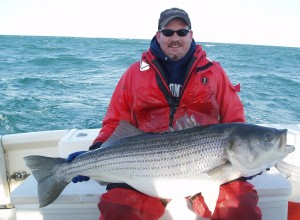 grow to fairly large size. They can be caught from shore, pier or boat. They are good table fare. They can be caught using just about any technique which you can think of. They fight pretty good. They are in our area all year but it is during the cold months, when many other species are not available, that you find the greatest numbers of striped bass in the mid-Atlantic. Now, with healthy striped bass stocks, you see as many boats out there during the winter as you see in the summer which is very good for the communities that depend on the business that recreational fishing generates.
grow to fairly large size. They can be caught from shore, pier or boat. They are good table fare. They can be caught using just about any technique which you can think of. They fight pretty good. They are in our area all year but it is during the cold months, when many other species are not available, that you find the greatest numbers of striped bass in the mid-Atlantic. Now, with healthy striped bass stocks, you see as many boats out there during the winter as you see in the summer which is very good for the communities that depend on the business that recreational fishing generates.
 Striped bass are caught using just about every technique imaginable but if you would like to consistently catch the largest of stripers, slip ‘em an eel. There are many good baits out there for large rockfish. Big spoons, jigs, plugs and various live fish baits all produce big fish but, day-in and day-out, the American eel outshines them all.
Striped bass are caught using just about every technique imaginable but if you would like to consistently catch the largest of stripers, slip ‘em an eel. There are many good baits out there for large rockfish. Big spoons, jigs, plugs and various live fish baits all produce big fish but, day-in and day-out, the American eel outshines them all.
Handling your bait
If you have a problem with slimy, snakelike creatures, get over it. There are a number of suggested ways for handling these slippery rascals. You can put them on ice to slow them down and once you have them on your hook,  they become active again after you get them back in the water. This works OK but some of them will not become active again. Another method is to use sand which sticks to the slime and makes it easier to hold the eel. This works well for surf casters but it will make a mess in your boat. I want my eels active so I keep them in my live-well, not on ice. I don’t want to mess with sand, a dry rag works just fine to control your eel. Get it out of the live-well with a bait net, grab it firmly with the rag, put it on your hook, and get it in the water. An occasional eel will have an attitude and will twist up your leader. Untangle it, this is just a price of fishing with eels.
they become active again after you get them back in the water. This works OK but some of them will not become active again. Another method is to use sand which sticks to the slime and makes it easier to hold the eel. This works well for surf casters but it will make a mess in your boat. I want my eels active so I keep them in my live-well, not on ice. I don’t want to mess with sand, a dry rag works just fine to control your eel. Get it out of the live-well with a bait net, grab it firmly with the rag, put it on your hook, and get it in the water. An occasional eel will have an attitude and will twist up your leader. Untangle it, this is just a price of fishing with eels.
Fishing Structure
 Striped bass like structure, we call them rockfish for a reason. Arguably, the best piece of striped bass structure in the world is the Chesapeake Bay Bridge Tunnel. Rockfish can be caught here all year. The largest fish will be there in November and December and eels are the top bait to catch them. The basic rig is a hook attached to a swivel by a 50-80 pound leader of about 3-4 feet. The other ring of the swivel is attached to your main running line. Above the swivel is a 3-4 ounce egg sinker or you can use a sinker slide so that you can change the size of your weight easily. Both circle hooks and J hooks are effective. If you find yourself deep-hooking fish, you should give circle hooks a try. While the entire structure holds fish, the majority of the largest fish will be caught at the northern end of the span. The pilings from the 4th island to Fisherman’s Island is the big fish zone. There are a number of ways to fish this area with eels. A popular technique is to tie off to a piling and fish eels at various depths along the piling that you are tied up too. You will find the fish suspended somewhere in the water column. Keep track on how deep your bait is so that you will know at what depth to drop back to after you catch your first fish. The most popular area to fish this way are the pilings just south of the high rise of the older span. This method is popular but you are not really supposed to do it. Tying off to the bridge is a no-no. An
Striped bass like structure, we call them rockfish for a reason. Arguably, the best piece of striped bass structure in the world is the Chesapeake Bay Bridge Tunnel. Rockfish can be caught here all year. The largest fish will be there in November and December and eels are the top bait to catch them. The basic rig is a hook attached to a swivel by a 50-80 pound leader of about 3-4 feet. The other ring of the swivel is attached to your main running line. Above the swivel is a 3-4 ounce egg sinker or you can use a sinker slide so that you can change the size of your weight easily. Both circle hooks and J hooks are effective. If you find yourself deep-hooking fish, you should give circle hooks a try. While the entire structure holds fish, the majority of the largest fish will be caught at the northern end of the span. The pilings from the 4th island to Fisherman’s Island is the big fish zone. There are a number of ways to fish this area with eels. A popular technique is to tie off to a piling and fish eels at various depths along the piling that you are tied up too. You will find the fish suspended somewhere in the water column. Keep track on how deep your bait is so that you will know at what depth to drop back to after you catch your first fish. The most popular area to fish this way are the pilings just south of the high rise of the older span. This method is popular but you are not really supposed to do it. Tying off to the bridge is a no-no. An 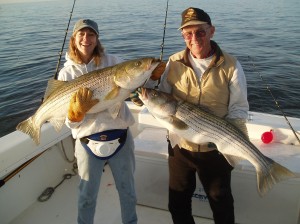 alternative to this is to simply hold your boat in the eddy on the down-current side of the piling with your boat’s engine and drop your eels down along the piling the same as if you were tied up. An advantage to this, besides being legal, is that it makes it easy to move from piling to piling until you find a hot one. It is not a problem to hold your boat up against the piling when the current is light. When it is ripping, you can still use this technique at the pilings of the high rise of the newer span. These wide pilings create a large eddy which makes it easy to keep your boat up next to the piling. This big eddy is also a very good place to find large striped bass waiting for prey to be swept around the piling. A third technique is to anchor up on the up current side of the bridge and drift eels back to the structure. Fish a couple of eels on the bottom with fish finder rigs. Have some suspended under floats and maybe free-line an eel or two back. All of these techniques are the most effective during the night-time hours.
alternative to this is to simply hold your boat in the eddy on the down-current side of the piling with your boat’s engine and drop your eels down along the piling the same as if you were tied up. An advantage to this, besides being legal, is that it makes it easy to move from piling to piling until you find a hot one. It is not a problem to hold your boat up against the piling when the current is light. When it is ripping, you can still use this technique at the pilings of the high rise of the newer span. These wide pilings create a large eddy which makes it easy to keep your boat up next to the piling. This big eddy is also a very good place to find large striped bass waiting for prey to be swept around the piling. A third technique is to anchor up on the up current side of the bridge and drift eels back to the structure. Fish a couple of eels on the bottom with fish finder rigs. Have some suspended under floats and maybe free-line an eel or two back. All of these techniques are the most effective during the night-time hours.
Open Water
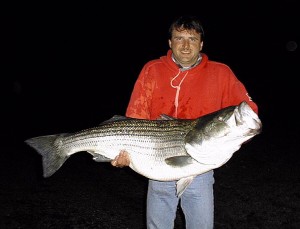 The advantage of fishing a hard structure like the Chesapeake Bay Bridge Tunnel is that it concentrates fish. That means that you do not have to cover much water to find fish and fishing with eels is not conducive to covering a lot of water. Luckily, when the big stripers are here, you usually do not have to. You can anchor up to fish a productive spot but most of boats will be drifting with a number of eels out waiting for a big fish to bite. The basic rig for fishing eels in open water is the same as that used at the bridge: a hook to your leader to you swivel to your main line. Above the swivel, you can place a weight and fish the baits suspended at various depths. These are your “down” rods. You can just drift a couple of eels back behind the boat with no weight on them. These are your “free-lines”. A third rig is to suspend your eels under slip-bobbers or balloons at various depths. The floats allow you to fish these suspended baits out away from the boat. These
The advantage of fishing a hard structure like the Chesapeake Bay Bridge Tunnel is that it concentrates fish. That means that you do not have to cover much water to find fish and fishing with eels is not conducive to covering a lot of water. Luckily, when the big stripers are here, you usually do not have to. You can anchor up to fish a productive spot but most of boats will be drifting with a number of eels out waiting for a big fish to bite. The basic rig for fishing eels in open water is the same as that used at the bridge: a hook to your leader to you swivel to your main line. Above the swivel, you can place a weight and fish the baits suspended at various depths. These are your “down” rods. You can just drift a couple of eels back behind the boat with no weight on them. These are your “free-lines”. A third rig is to suspend your eels under slip-bobbers or balloons at various depths. The floats allow you to fish these suspended baits out away from the boat. These 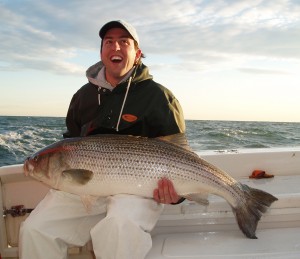 colorful floats make it easy to see when you have found the “bobber fleet”. The purpose of fishing with bobbers, free-lines, and down rods is that, with a little thought, they allow you to fish a number of eels at various depths without creating a big, tangled mess. If you find that you are getting most of your bites on one rod, fish more of your eels at that depth.
colorful floats make it easy to see when you have found the “bobber fleet”. The purpose of fishing with bobbers, free-lines, and down rods is that, with a little thought, they allow you to fish a number of eels at various depths without creating a big, tangled mess. If you find that you are getting most of your bites on one rod, fish more of your eels at that depth.
This technique is very effective wherever large striped bass may be encountered. Smith Island Flats, the area of the 4A buoy, and the area of the CBJ buoy are all good places to drift eels. The main spot 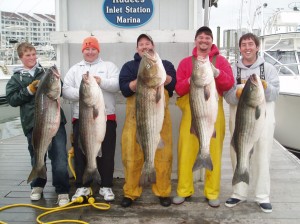 this technique is used is along the Eastern Shore side of the Chesapeake Bay from buoy 18 to buoy 36A. This includes the Concrete Ships and Plantation Light, locations you will hear often during big-fish reports. This open-water drift fishery is primarily a day-time fishery. You do this all day and then fish the Chesapeake Bay Bridge Tunnel all night. You can sleep when striper season is over.
this technique is used is along the Eastern Shore side of the Chesapeake Bay from buoy 18 to buoy 36A. This includes the Concrete Ships and Plantation Light, locations you will hear often during big-fish reports. This open-water drift fishery is primarily a day-time fishery. You do this all day and then fish the Chesapeake Bay Bridge Tunnel all night. You can sleep when striper season is over.
